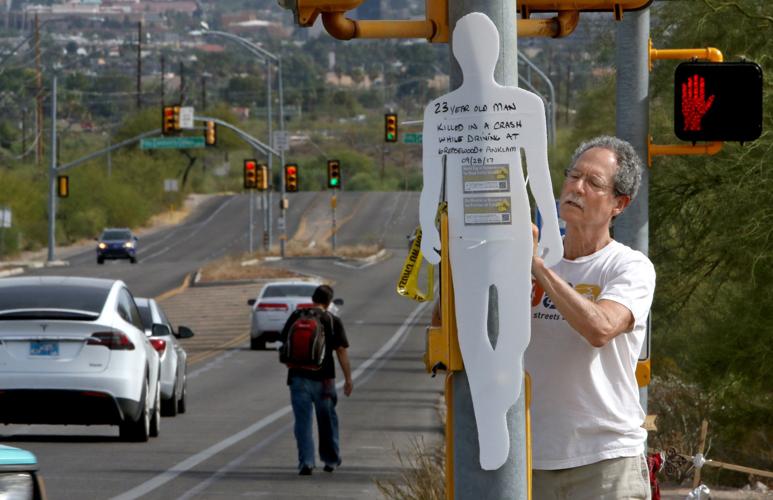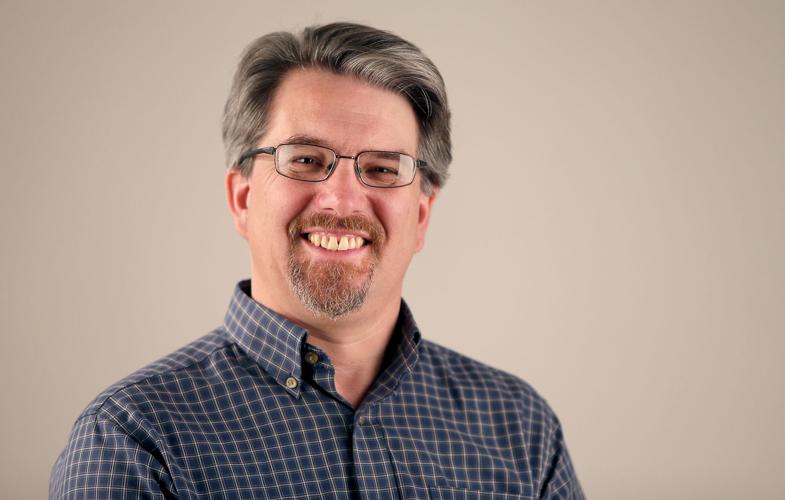Clem Mentzer and his sister Anna lived in adjoining properties in the midtown neighborhood where they grew up.
They saw each other daily, and Anna’s sons were the closest thing Clem had to his own children.
Now one of those nephews effectively is his son, and the other is gone.
On Oct. 11, Clem Mentzer was forced to join a network of unfortunates when his sister Anna and her son Ethan were struck and killed while crossing East Pima Street to St. Cyril School. Ethan’s 10-year-old brother, Eli, survived because he was home sick that day, and Clem now cares for him.
Today, Sunday, Nov. 19, the Living Streets Alliance is holding a vigil and call to action in coordination with the World Day of Remembrance for Road Traffic Victims. It’s from 4:30 to 5:30 p.m. at Tucson City Hall.
There is such a day, of course, because there are so many victims.
Around Tucson this week, alliance members posted white silhouettes of 57 people at the 53 sites where people have been killed by motor vehicles this year. Of those 57 victims, 28 were riding bikes or walking, and the remaining 29 were in motor vehicles themselves.
Mentzer and his nephew are two of the area’s survivors, reeling as most people do from the abrupt end of the normal lives they knew and the sudden loss of their loved ones. They’re getting by with help from St. Cyril’s and the boys’ godmother. But it is hard.
“My nephew and I have been trying to get through it as best as we can. He’s had a lot of support, which I’m happy about,” Mentzer told me.
“I feel fortunate that I’m not emotionally paralyzed by the event,” he said. “I don’t have the time. I have to help him.”
As you know if you’ve kept up with the news or read my columns, this has been a terrible year in Tucson for pedestrians, with 26 dying from being struck by cars, according to the Alliance’s count. But you may not have noticed bicyclists are being victimized, too, inside and outside of Tucson city limits.
I met two survivors Friday at the bicycle expo at the Tucson Convention Center that precedes El Tour de Tucson. Brendan Lyons, who is executive director of the traffic-safety group Look! Save a Life — and has twice been struck by cars while riding his bicycle — brought together Deborah Breslin and Beverly Lucke. Both of them lost their 61-year-old husbands this year.
As they told their stories, they concluded the two men, Tim Breslin and Robert Lucke, would probably have gotten along famously if they’d known each other.
“They sound very similar,” Beverly Lucke said. “They probably would have been cycling buddies.”
Instead, Robert Lucke, who lived in Oro Valley, died under the wheels of a truck on Feb. 16 at South Sixth Avenue and 36th Street in South Tucson. A car struck Breslin near West Sahuarita Road and South La Cañada Drive on Oct. 13. He died on Nov. 10 after nearly a month in the hospital.
“I always thought Tim would pull though this,” Deborah Breslin said. “Now it’s on my shoulders, and I believe I know what he wants me to do.”
In the Tucson area, many people are already searching for ways to address the problem. At a Tucson Pedestrian Advisory Committee meeting Wednesday night, I heard both that this problem is not just a Tucson thing, and that it really is a Tucson thing.
It isn’t a Tucson thing in that pedestrian deaths are rising nationwide. They rose by 25 percent from 2010 to 2015, according to a report this year from the Governors Highway Safety Association, then they spiked by 11 percent in 2016 compared to 2015.
And yet, the problem is worse in certain places. Seattle, which has a population of about 704,000, had a total of six pedestrian deaths and two bicyclist deaths in 2016. So far this year, the city is doing a little worse, with 10 pedestrian deaths and one cyclist death. But that is, of course, much better than Tucson, population about 526,000.
Police Chief Chris Magnus told the committee Wednesday he has noticed in his jobs as a chief that local culture and enforcement simply means drivers respect pedestrians more in some places.
In his home state, Michigan, “the car was king,” Magnus said. But then he became police chief in Richmond, Calif., in the San Francisco Bay area.
There, he said, “you stop. Pedestrians and bicyclists are on an equal footing. Moving back here (to Tucson), it’s like I’m back in Michigan again.”
The Police Department has been hampered by low staffing, he said. Officers often are so backed up on higher-priority calls that they don’t have time to enforce traffic laws.
“We know that by not dealing with the traffic situation as aggressively as we’d like to, we’re going to have accidents,” he said.
“You don’t have to impress upon me the seriousness of this problem. It’s very, very significant and we’ve got to get a handle on it.”
But enforcement isn’t the only solution. Increasingly, groups like the Living Streets Alliance and the police are asking for help from traffic engineers to slow down traffic, improve visibility or better separate pedestrians and bicycles from motor vehicles.
“Engineering is, in some ways, the elephant in the room,” Magnus said.
Tucson’s main streets are almost all designed like highways, just with lower speed limits. They give drivers an unconscious signal it’s OK to go fast. And those main streets, like the aptly named Speedway, are where the vast majority of the pedestrian deaths occur.
In Seattle, the city has begun lowering speed limits and reconfiguring roads in order to limit traffic deaths. It has a program called Vision Zero intended to reduce all traffic deaths to zero by 2030.
While the Living Streets Alliance has begun working on an initiative to promote “complete streets” for Tucson, we are far from having streets that all users can share safely. In the Tucson area, we’re still in the stage of accumulating and memorializing victims, like Anna and Ethan Mentzer, Tim Breslin and Robert Lucke.





